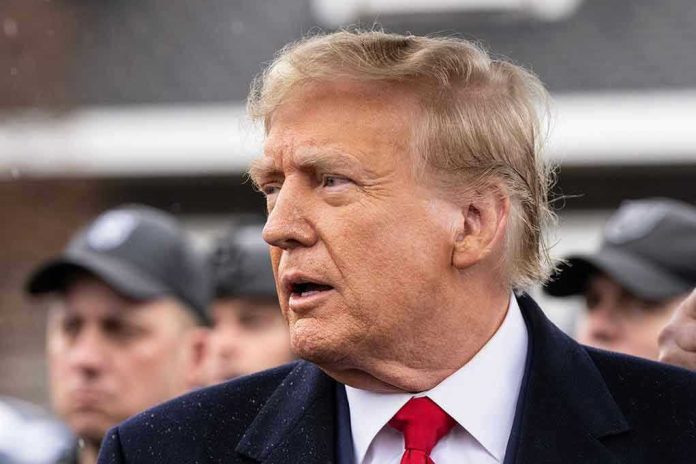
A historic $4.9 billion cut to foreign aid by President Trump has ignited fierce debate, as supporters cheer a long-awaited rollback of globalist spending while critics warn of risks to U.S. influence and humanitarian commitments.
Story Snapshot
- President Trump slashes $4.9 billion in foreign aid, targeting USAID and State Department programs.
- The move marks the largest single-year reduction in U.S. foreign aid in decades, with immediate freezes on payments and project work.
- Supporters hail the cuts as a victory for “America First,” prioritizing domestic needs and fiscal restraint after years of unchecked spending.
- Critics in Congress and aid groups warn of lost global influence, humanitarian harm, and legal battles over executive authority.
Trump’s $4.9 Billion Foreign Aid Cut: A Turning Point for U.S. Priorities
President Donald Trump’s administration announced a $4.9 billion reduction in congressionally-approved foreign aid, directly targeting programs run by the U.S. Agency for International Development (USAID) and the State Department. This decision, described by White House officials as a necessary restructuring, represents the largest cut to American foreign assistance in decades and comes after a sweeping executive order triggered a 90-day review of all U.S. foreign aid. Payments and ongoing project services were immediately frozen, drawing praise from fiscal conservatives and outcry from global aid advocates.
For many Trump supporters, these cuts deliver on long-standing frustrations with wasteful spending and international entanglements. The administration argued that billions sent overseas could be better used at home, especially after years of rising deficits and inflation blamed on prior fiscal mismanagement. By halting payments and demanding new oversight, the cuts signal a clear pivot toward an “America First” agenda—one that aims to secure the border, strengthen the economy, and restore accountability to how taxpayer dollars are spent. This move also puts pressure on Congress, which has historically resisted such deep reductions, to reconsider its approach to funding programs abroad.
Immediate Fallout: Legal Battles and Humanitarian Waivers
The sweeping nature of the cuts led to immediate legal challenges from both domestic lawmakers and international organizations. Congress, which holds the constitutional power of the purse, pushed back against the executive branch’s authority to freeze or redirect appropriated funds, while bipartisan coalitions publicly opposed the cuts, citing risks to global health and security. The administration issued limited waivers for critical humanitarian assistance, but these exceptions have been difficult to obtain and do not cover the majority of disrupted programs. Large-scale layoffs hit USAID and its contractors, creating uncertainty for thousands of aid workers and recipient communities worldwide.
Despite the administration’s defense that the cuts would make aid more efficient and aligned with U.S. interests, critics warn that freezing support to key health, refugee, and development initiatives could have severe short-term and long-term consequences. Aid-dependent populations face heightened risks of disease, hunger, and displacement, while the sudden withdrawal of U.S. funding threatens to erode longstanding diplomatic relationships. The move has also sparked concerns about America’s global leadership, as rival powers may step in to fill the void left by American retreat.
Impact on U.S. Influence and Domestic Priorities
Supporters of the aid cuts argue that decades of unchecked foreign assistance have failed to yield meaningful results for the American people, often propping up corrupt regimes or funding projects misaligned with U.S. values. By slashing the budget and freezing questionable programs, the administration aims to redirect resources to pressing domestic needs, from border security to rebuilding infrastructure and supporting American families. This aligns closely with conservative priorities: protecting constitutional rights, ensuring fiscal responsibility, and resisting globalist agendas that undermine national sovereignty.
At the same time, aid organizations and experts caution that the abrupt scale and speed of the cuts could undermine both humanitarian goals and U.S. national security. The contraction of the global aid sector may leave vulnerable populations at greater risk, and the U.S. could lose leverage in regions critical to counterterrorism, trade, and geopolitical competition. While some other donor countries may step in, few have the capacity to match the scope of American assistance now in jeopardy.
Debate Over America’s Role Abroad: Voices and Perspectives
Industry experts and bipartisan congressional reports largely warn that the scale of the cuts could have catastrophic impacts on vulnerable populations and global stability. However, advocates for reform argue that U.S. foreign aid has long required more oversight and efficiency, and that this moment offers a chance to refocus on programs that truly serve the nation’s interests. The legal fight over executive authority—whether the White House can override congressional appropriations—remains unresolved, adding further uncertainty to the future of U.S. foreign assistance. This debate reflects a broader struggle over America’s identity: should the nation lead abroad, or put its own people first at home?
As the administration stands firm, the coming months will reveal whether this historic rollback of foreign aid marks a lasting shift in U.S. policy or a flashpoint in a continuing battle over America’s role in the world. For many who have long demanded an end to government overreach and globalist priorities, this is a clear sign that the new administration is keeping its promises and putting American interests back on top.
Sources:
Impact of Foreign Assistance Cuts – Better World Campaign
U.S. Foreign Aid Freeze, Dissolution of USAID: Timeline of Events – KFF









